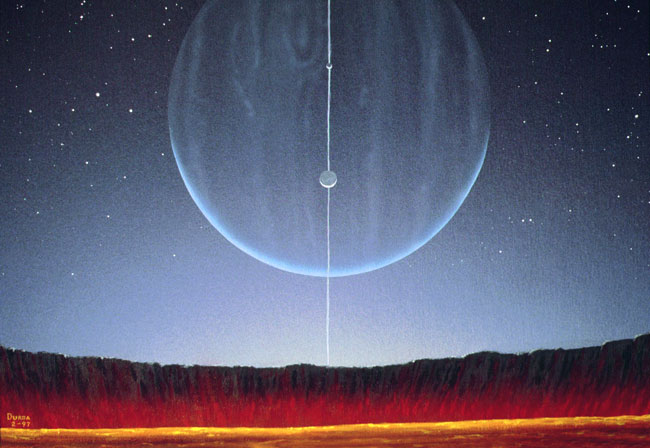Explanation: Could an asteroid destroy civilization on Earth? Mountain-sized space rocks could potentially impact the Earth causing global effects, and perhaps even be mistaken for a nuclear blast of terrestrial origin. Such large impacts are rare but have happened before. Modern telescopes have therefore begun to scan the skies for signs of approaching celestial hazards. Over the past year, projects such as Spacewatch and Spaceguard have continually discovered previously unknown asteroids that indeed pass near the Earth. Such projects are still rather modest, however. In June, 100-meter asteroid 2002 MN was discovered only after it whizzed by the Earth, crossing even within the orbit of the Moon. This year brought much discussion in the astronomical community of expanding technology to discover most large Near Earth Objects and extend the time between discovery and impact for all potential astronomical hazards. Pictured above is an illustration of a busy planetary system, showing the view of a planet ringed with space debris from a recently formed crater of an orbiting moon.
1998 1999 2000 2001 2002 2003 2004 2005 2006 2007 2008 2009 2010 2011 2012 2013 2014 2015 2016 2017 2018 2019 2020 2021 2022 2023 2024 |
Январь Февраль Март Апрель Май Июнь Июль Август Сентябрь Октябрь Ноябрь Декабрь |
NASA Web Site Statements, Warnings, and Disclaimers
NASA Official: Jay Norris. Specific rights apply.
A service of: LHEA at NASA / GSFC
& Michigan Tech. U.
|
Публикации с ключевыми словами:
asteroid - impact - Solar System - Near Earth Objects - астероиды - столкновения - солнечная система - Околоземные космические объекты
Публикации со словами: asteroid - impact - Solar System - Near Earth Objects - астероиды - столкновения - солнечная система - Околоземные космические объекты | |
См. также:
Все публикации на ту же тему >> | |
